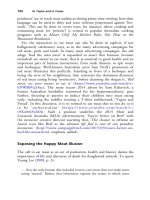The palgrave international handbook of a 233
Bạn đang xem bản rút gọn của tài liệu. Xem và tải ngay bản đầy đủ của tài liệu tại đây (26.62 KB, 1 trang )
228
J. Maher and T. Wyatt
or smuggling for much wildlife. For instance, ENDCAP (2012) reports that
60 % of wildlife kept as companion animals die within one month of
purchase and that 70 % of wildlife living in pet stores die within six weeks.
The harms experienced are similar to those reported in the farming of
domesticated animals—who are subjected to brutal practices and living
conditions (Wyatt 2013a). Here, though, the exploration is of those wildlife
taken from the wild and forced to endure being traded, smuggled and/or
killed to be made into products for human consumption.
Capture
Those animals kidnapped alive for legal and illegal wildlife trades are captured with nets, snares, pits and leg-traps (Wyatt 2013c). Each of these
methods is stressful in its own way to the animals subjected to it. In addition
to the obvious mental and emotional trauma of being captured, each method
also has the potential to cause physical injury. The fur trade clearly demonstrates the type of physical injury to which wildlife is subjected. For capturing
fur-bearing mammals, some countries still allow the use of steel-jawed legtraps (Wyatt 2014). As Harrop (2000) has noted, these traps can cause
fractures, tissue damage, amputations, lacerations and dislocations of all of
the limbs as well as the skull. Clearly, all these injuries cause significant pain
and suffering. None of these methods for capturing animals alive is shortterm in that the animal is trapped for indeterminate amounts of time until
the poacher returns to check the net, snare, pit or trap. Whereas in the EU,
this is supposed to be no longer than five minutes (Harrop 2000) (arguably
still a long time), in other countries where fur-bearing mammals are captured, such as Russia and China, there is no such animal welfare legislation.
This clearly causes further suffering and the potential for injury as animals
attempt to free themselves. Wildlife have been known to self-mutilate and
become unresponsive due to the injury caused by leg-traps (Harrop 2000).
Additionally, the wildlife has no access to food or water and may be exposed
to severe weather conditions while confined to the trap. For some species
captured alive, such as great apes, there is additional injury and death to the
other individuals who are not being captured. For instance, adult great apes
are killed when poachers come to kidnap the babies (Great Ape Survival
Project [GRASP] 2012). Experts estimate that for every live great ape taken
one to 15 others have been murdered (Nellemann et al. 2010; Nijman
2009). Once wildlife are kidnapped, they must endure being used to produce
a product, being smuggled to a market or other place to be sold or killed.









